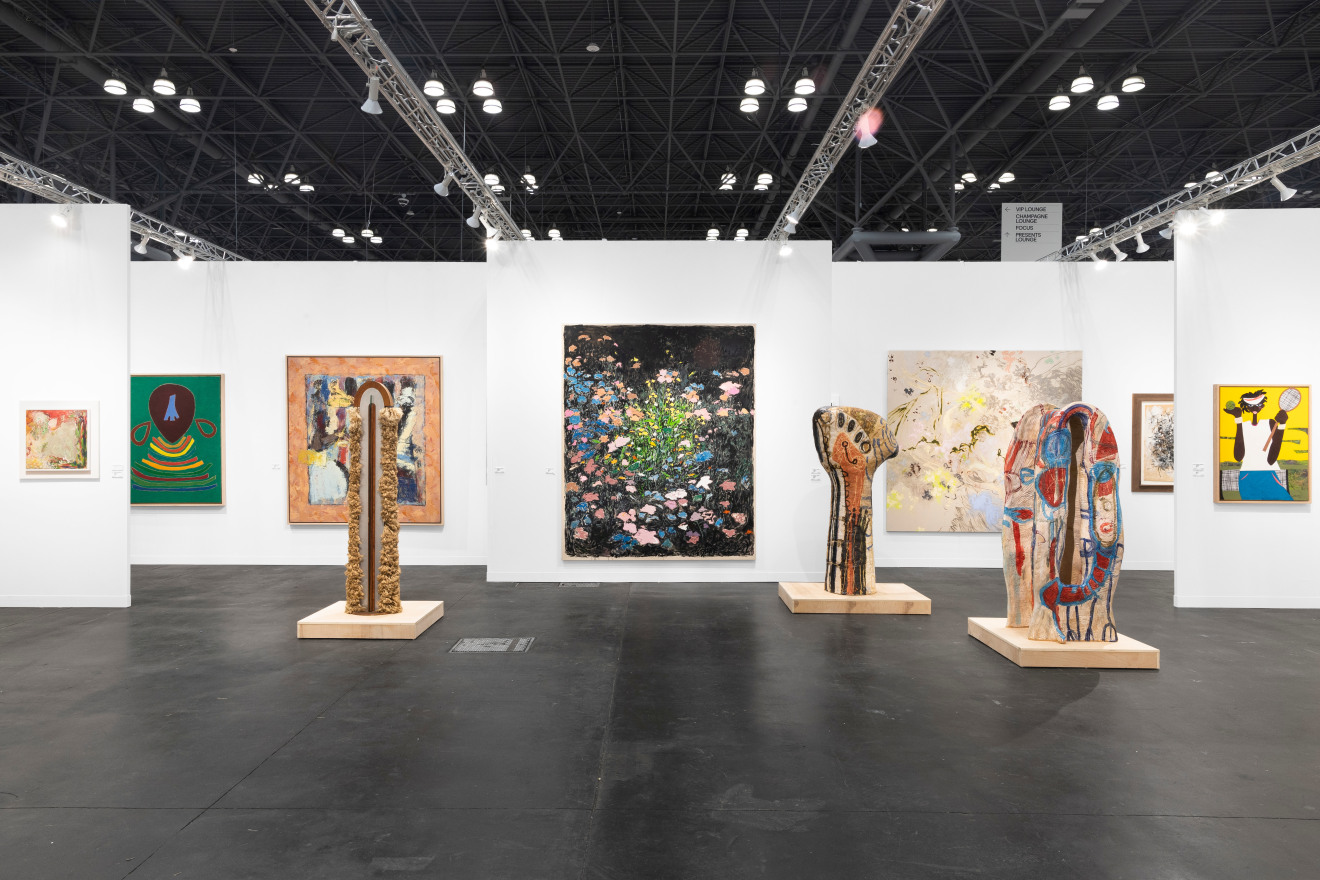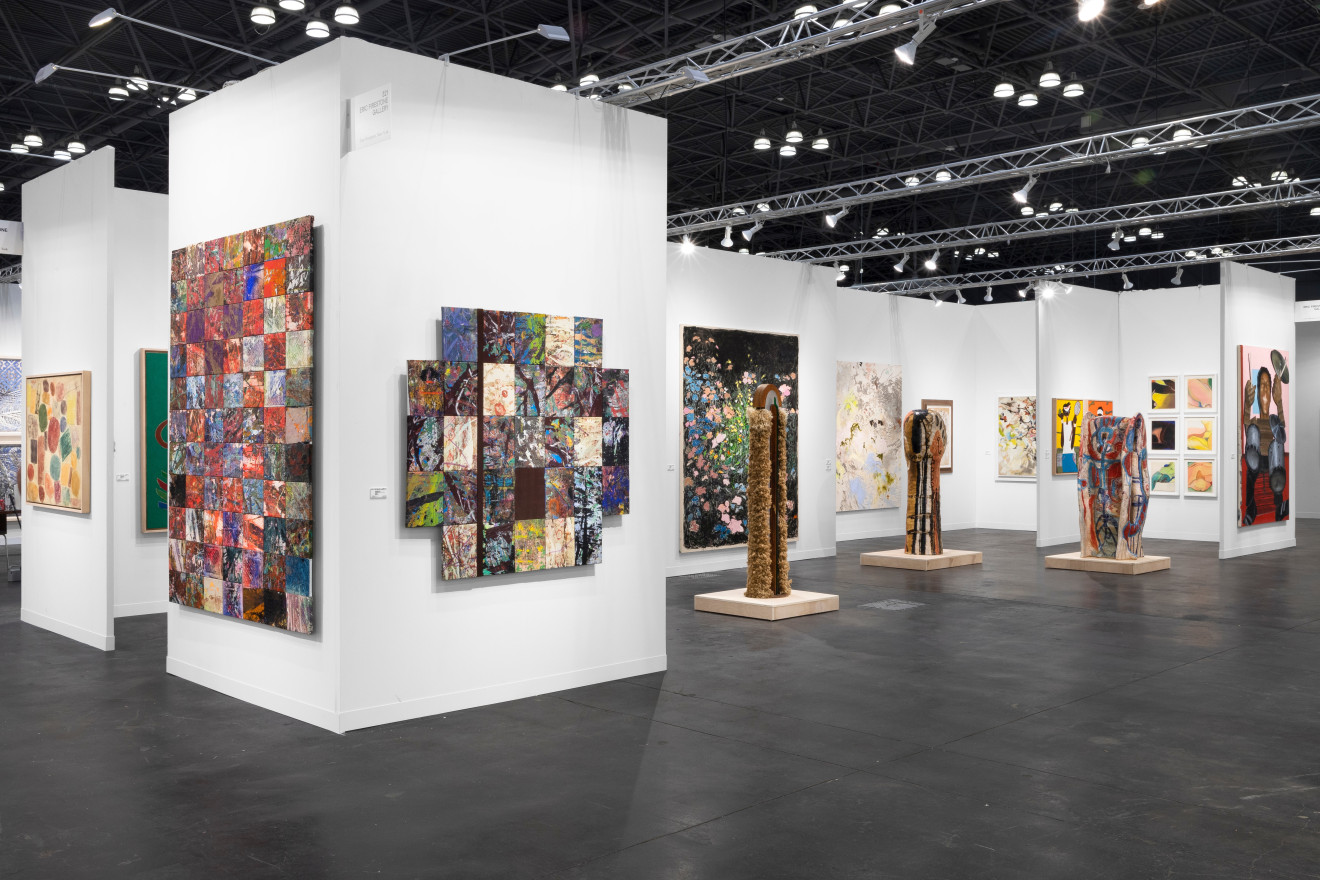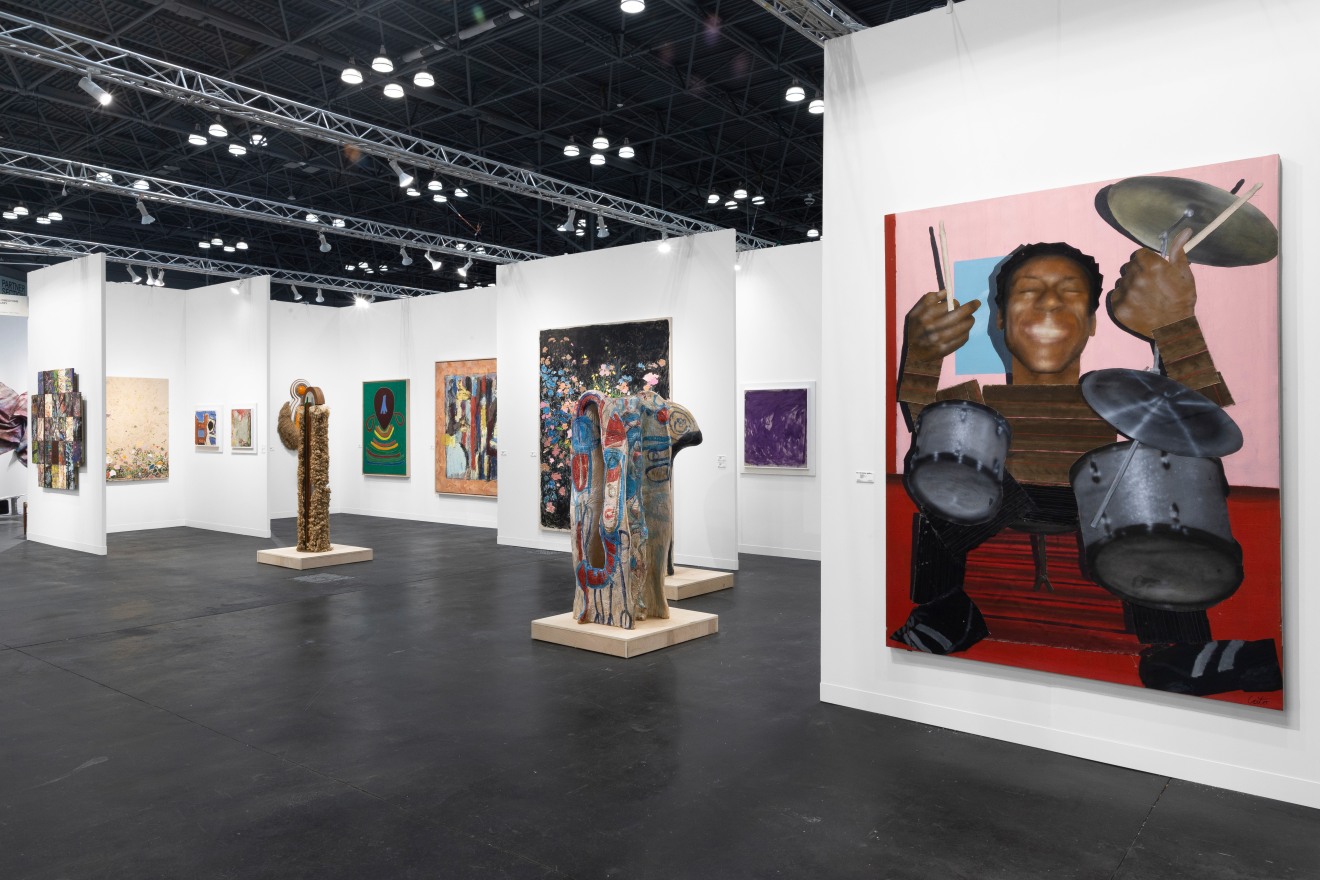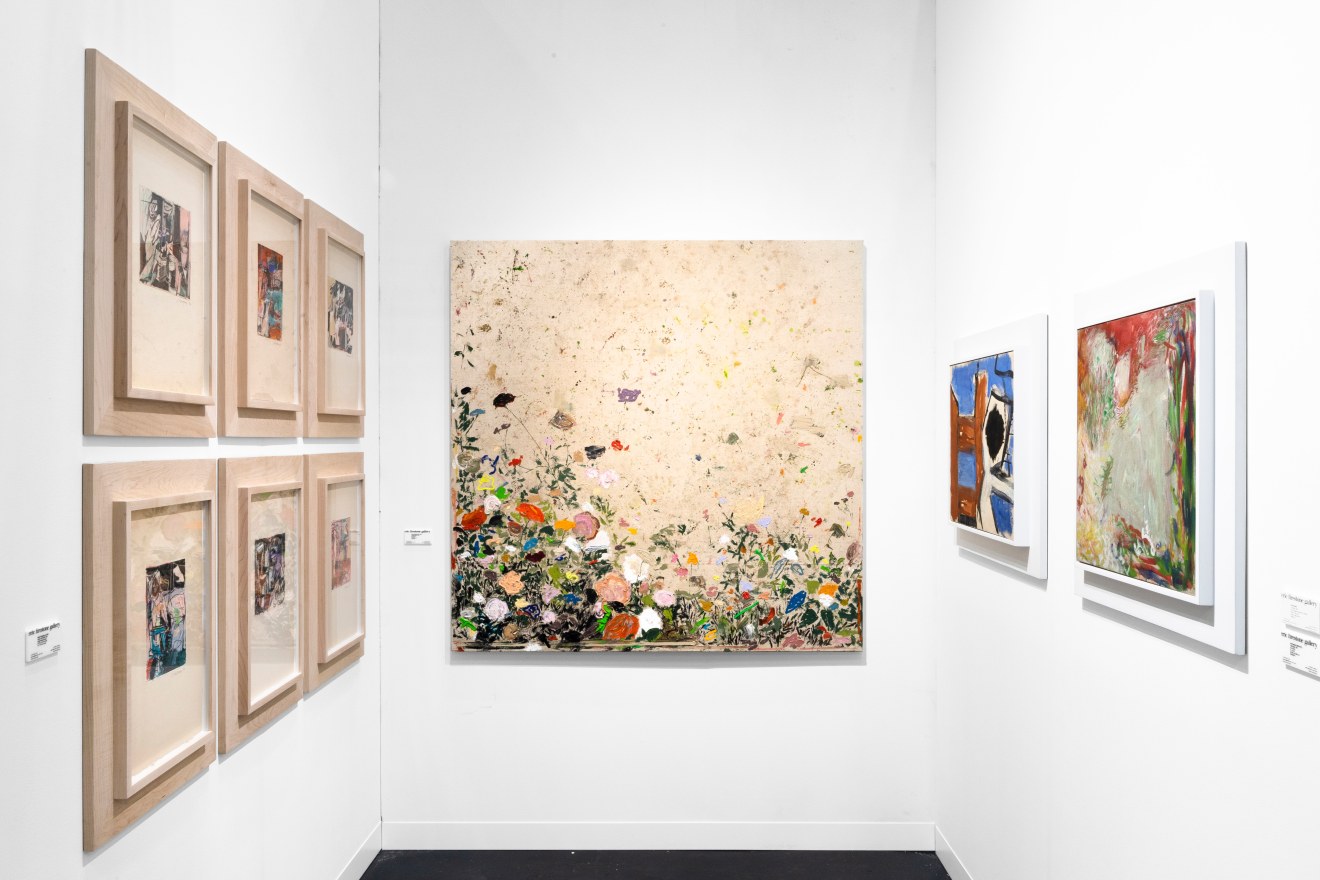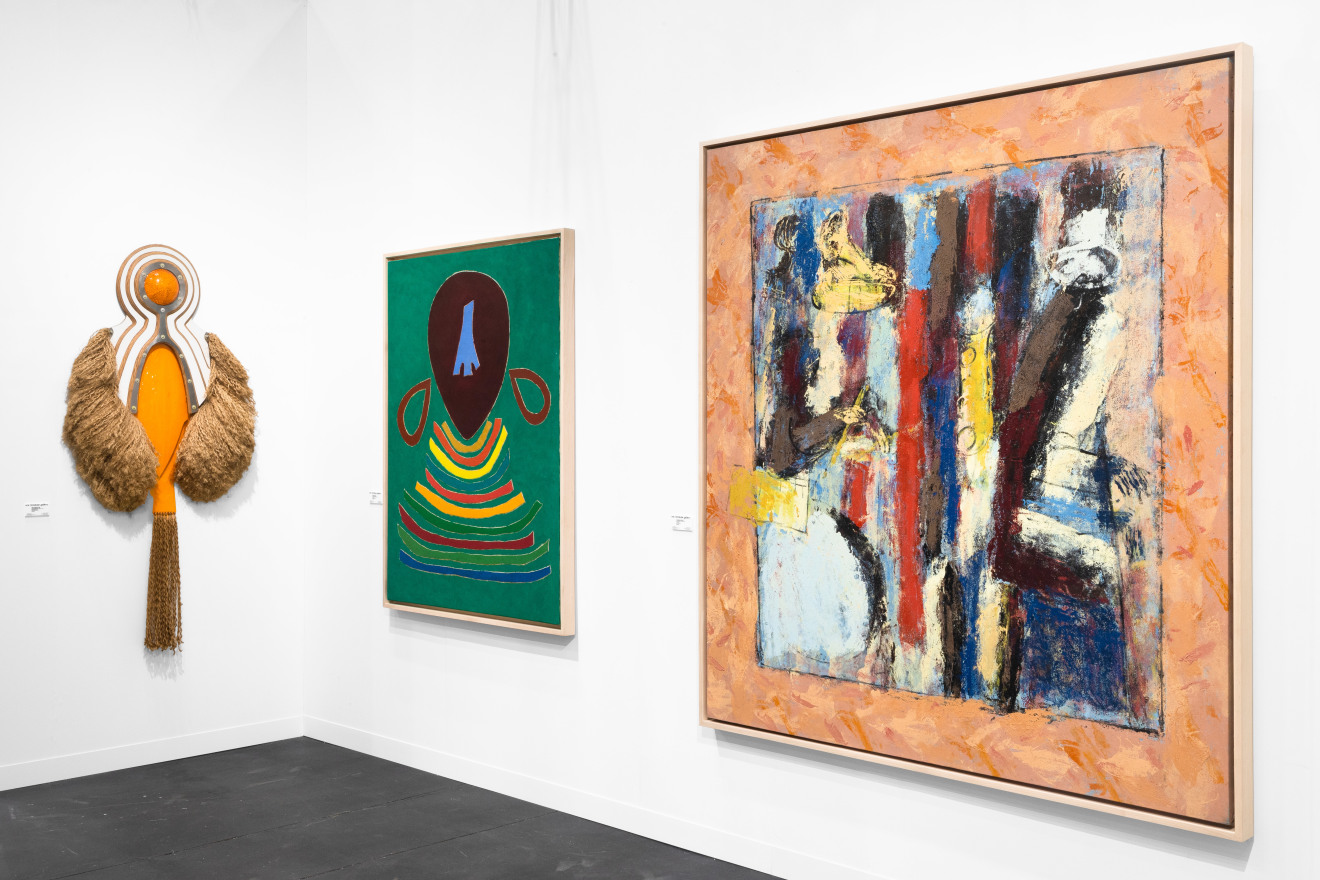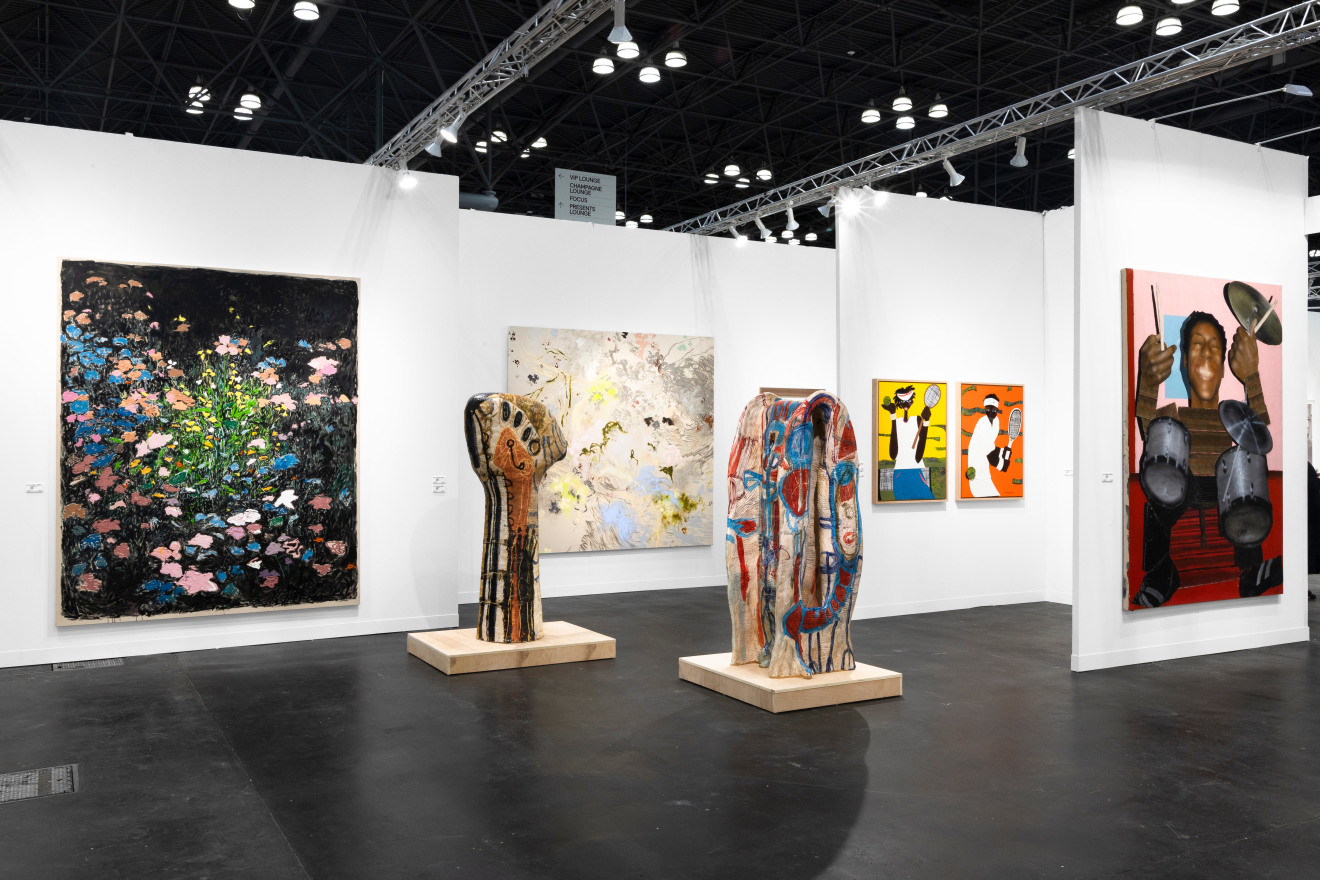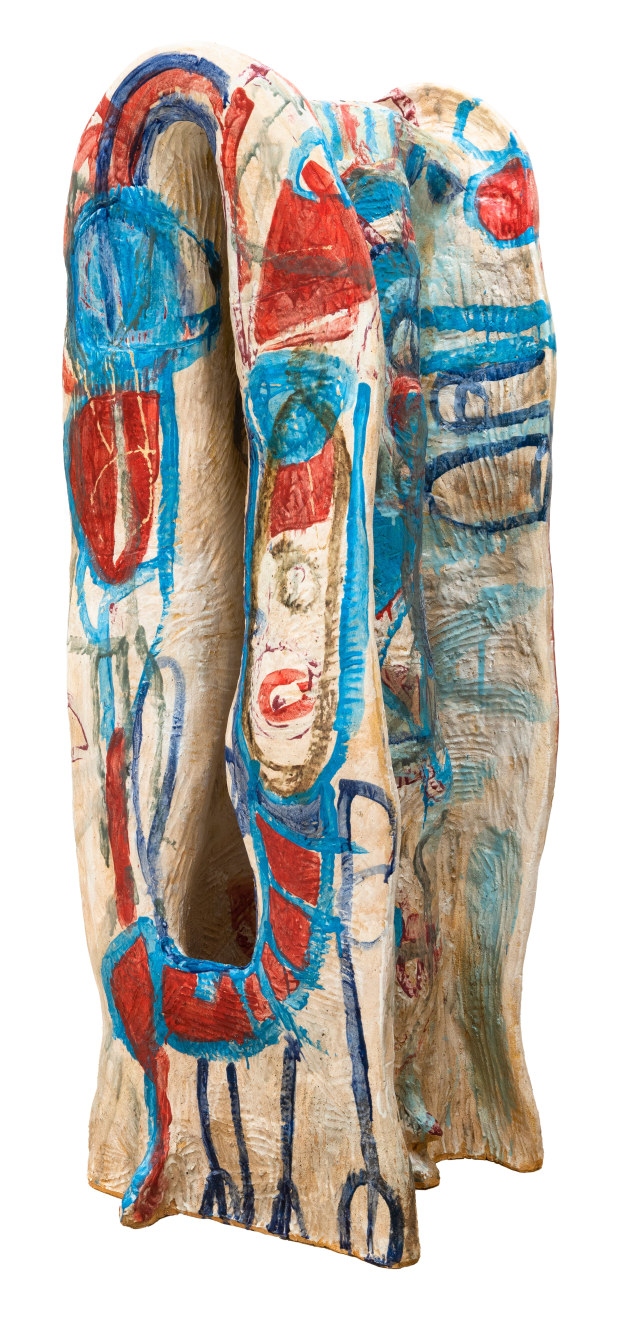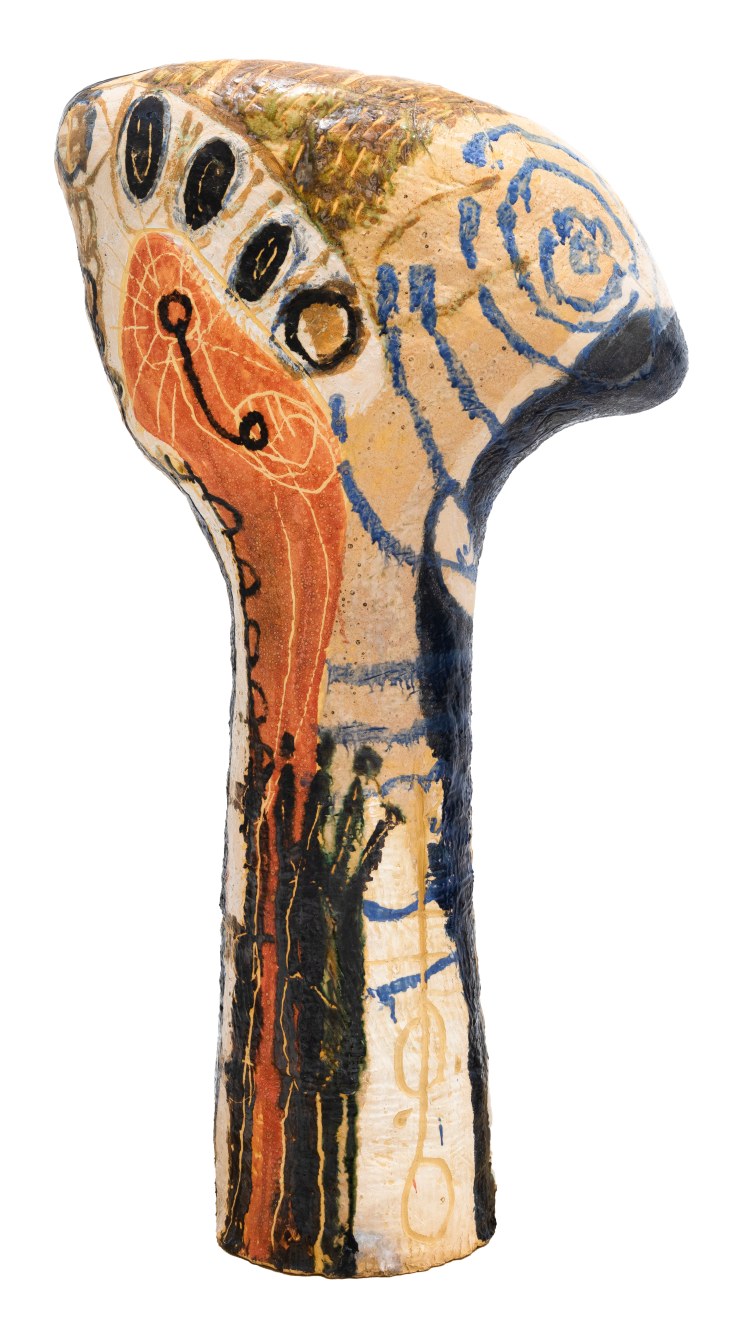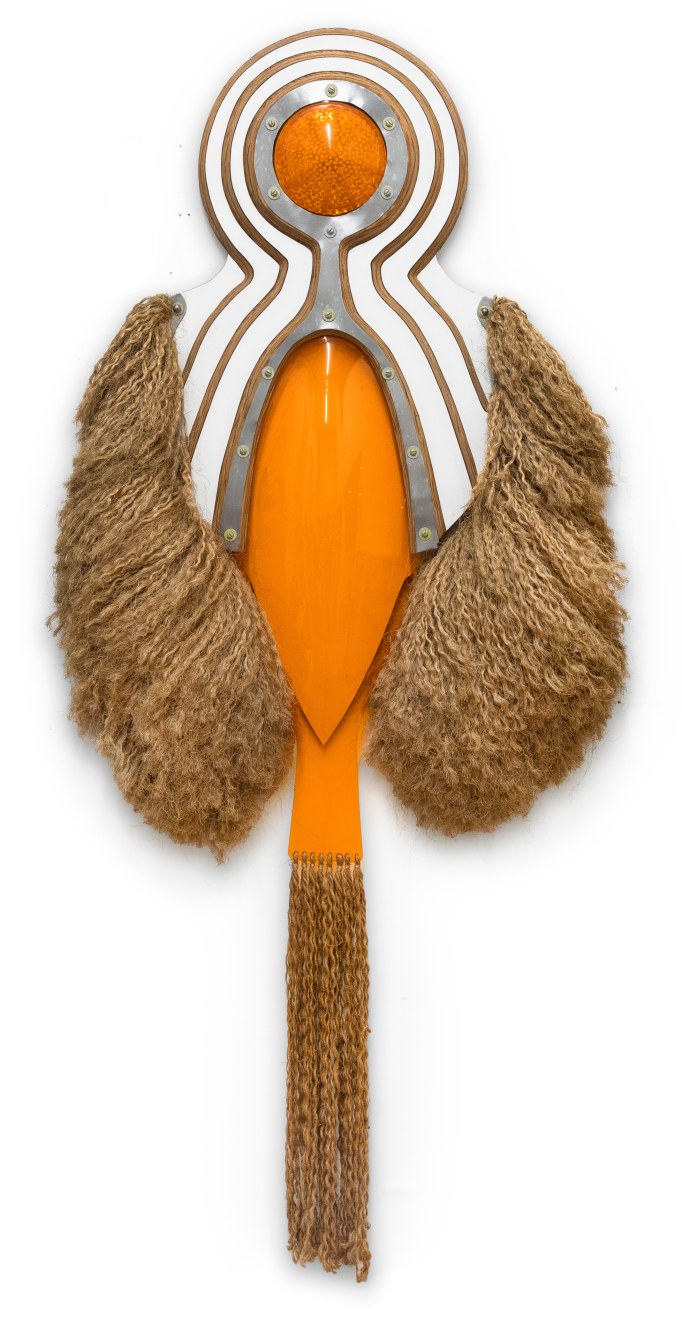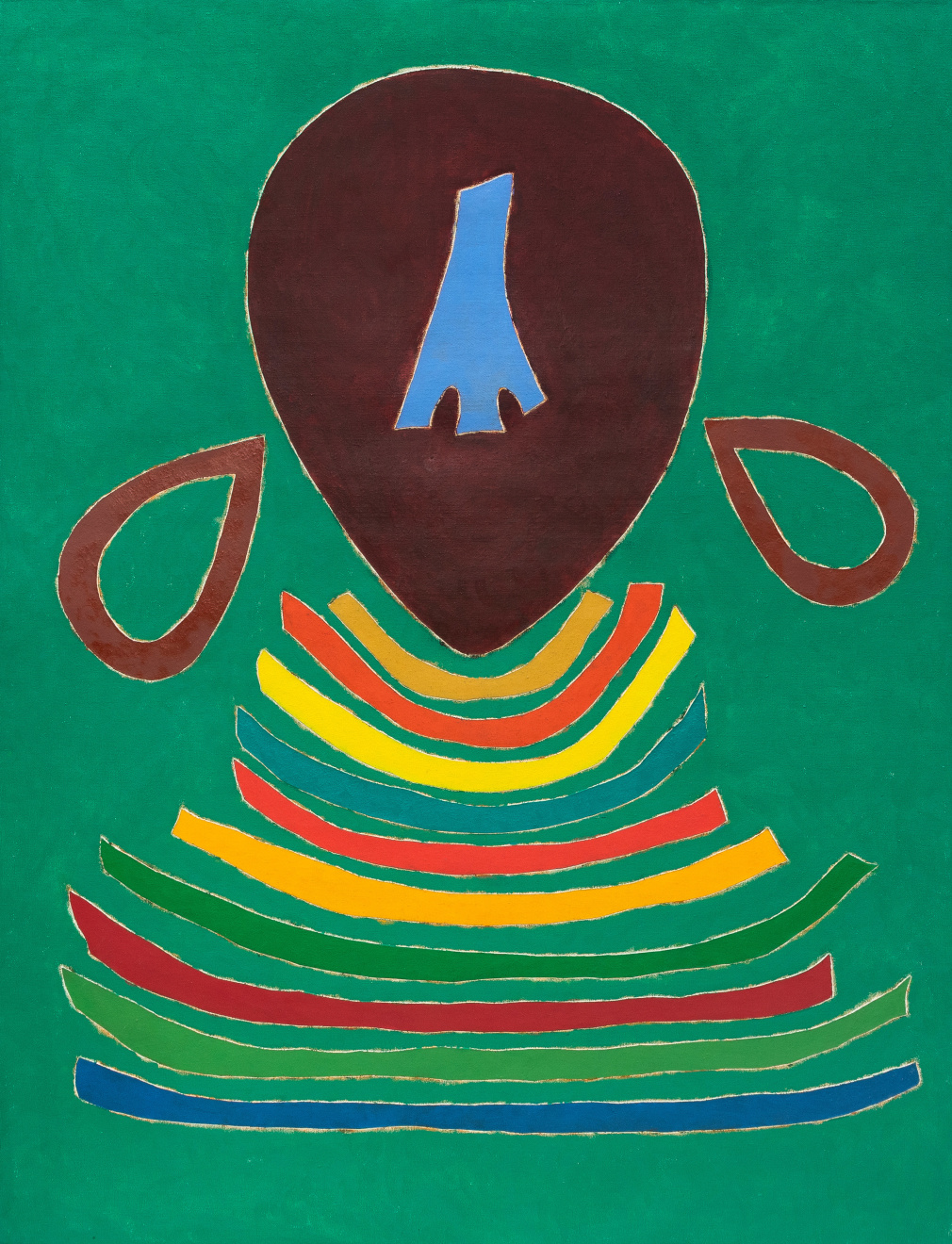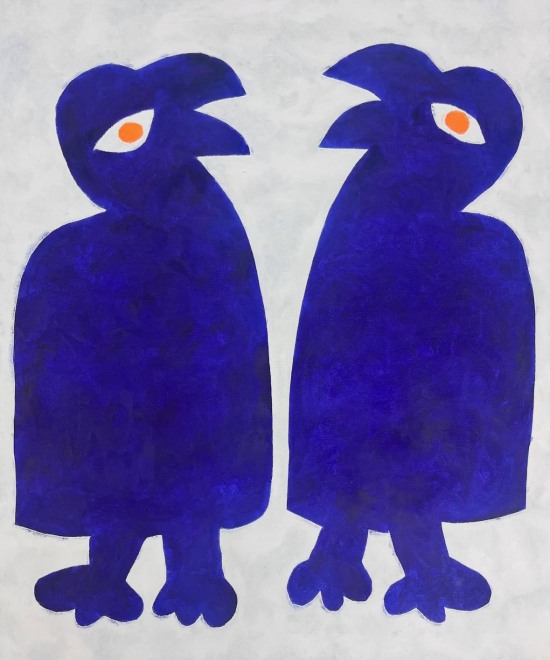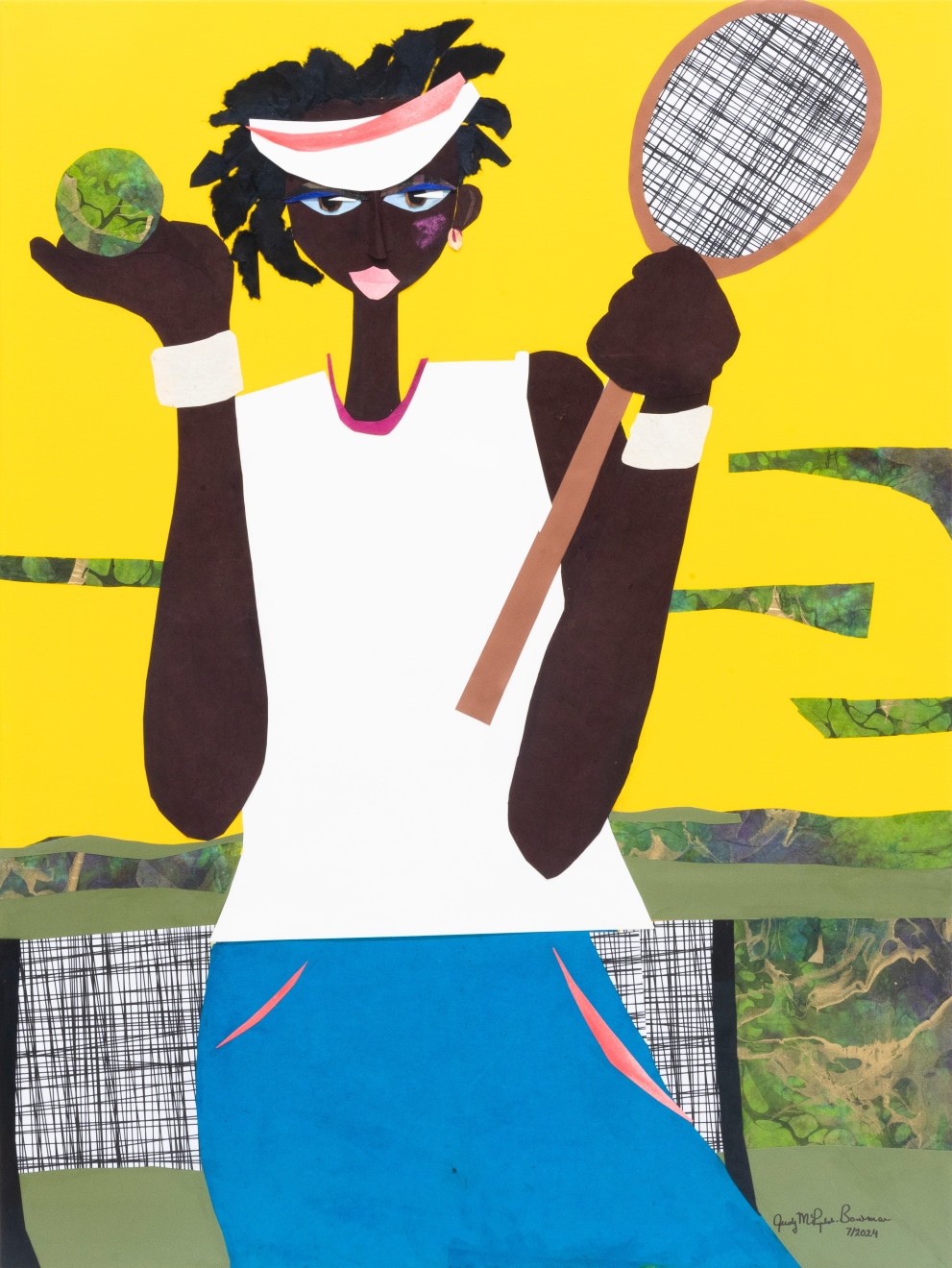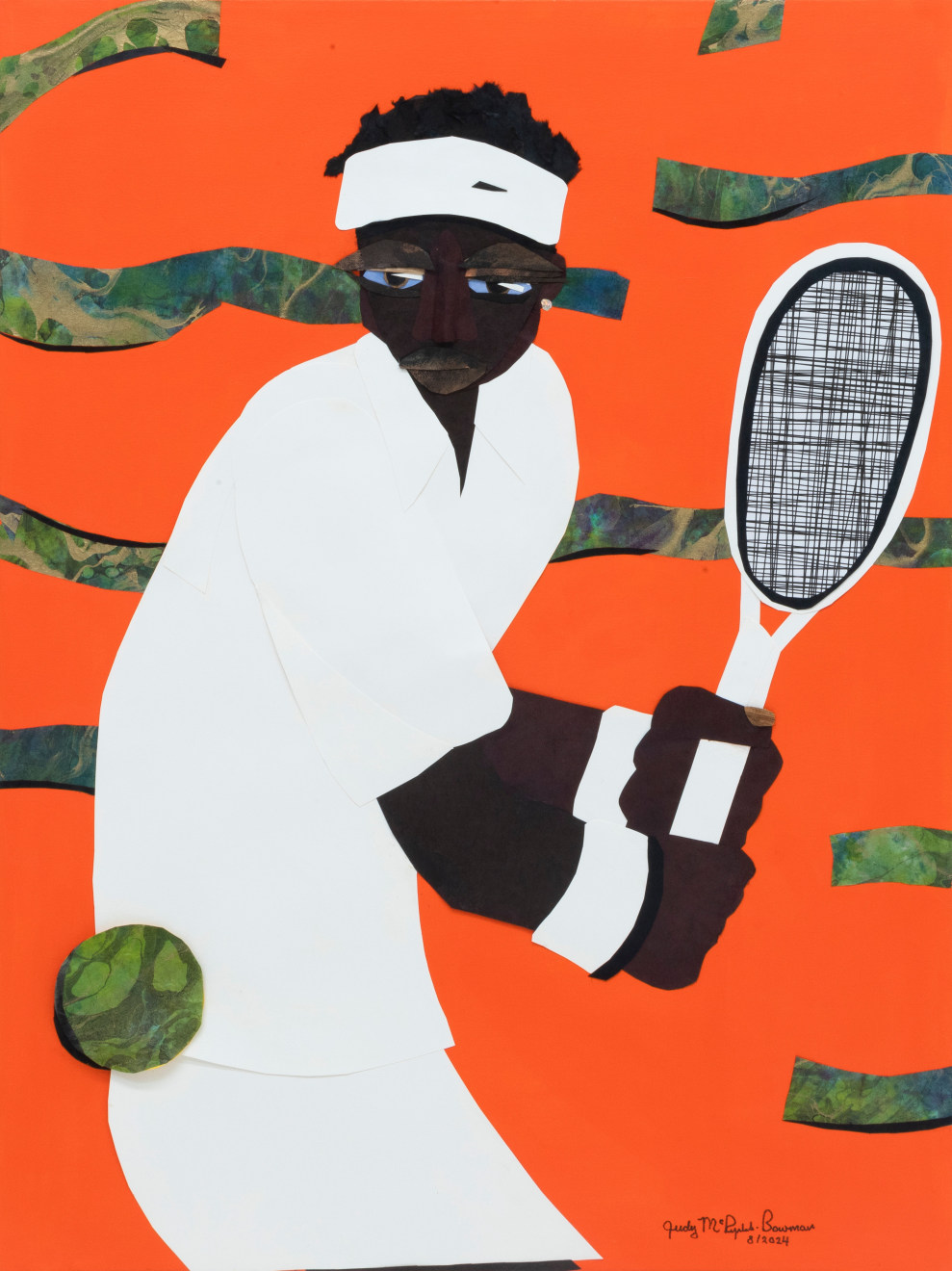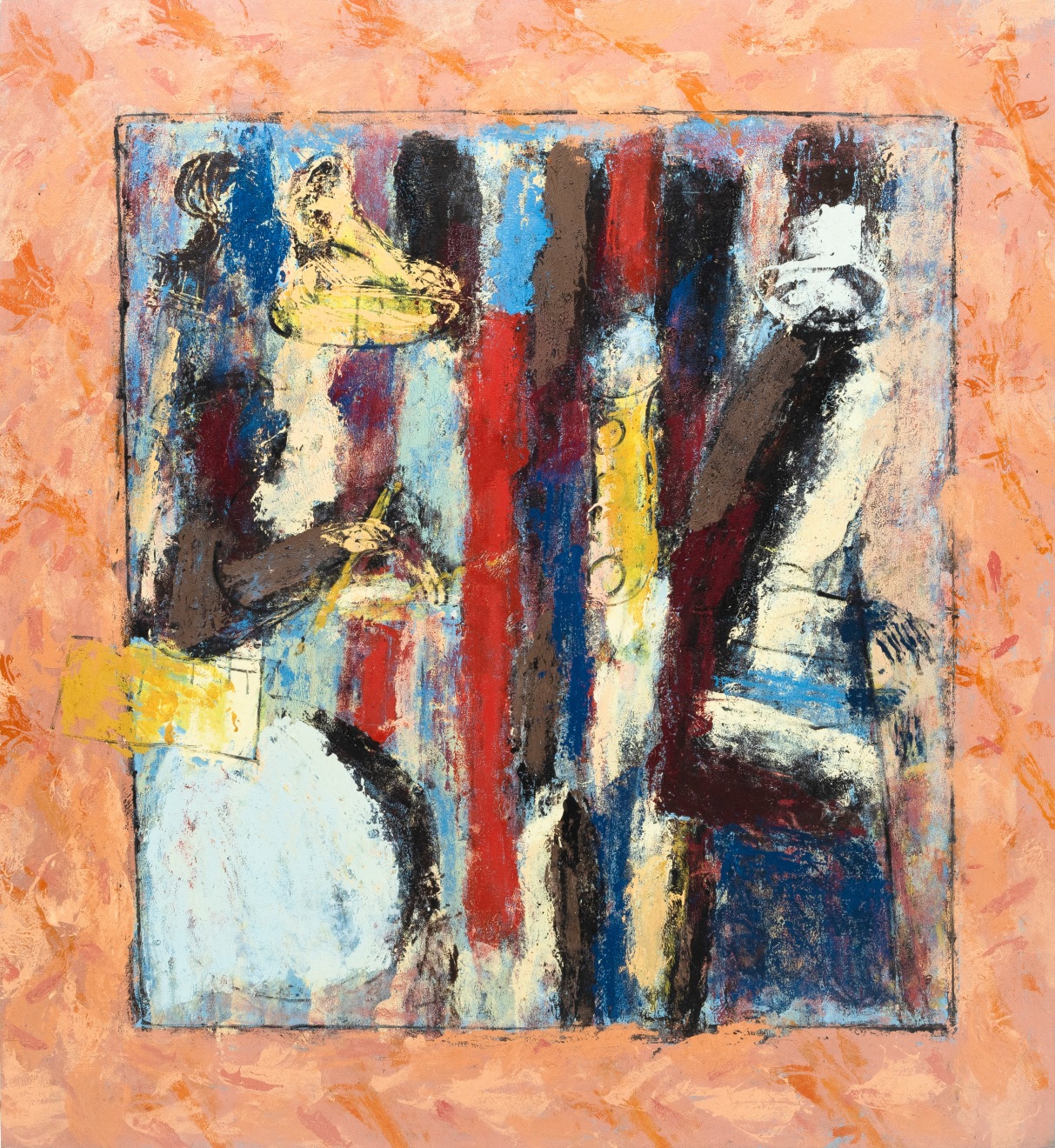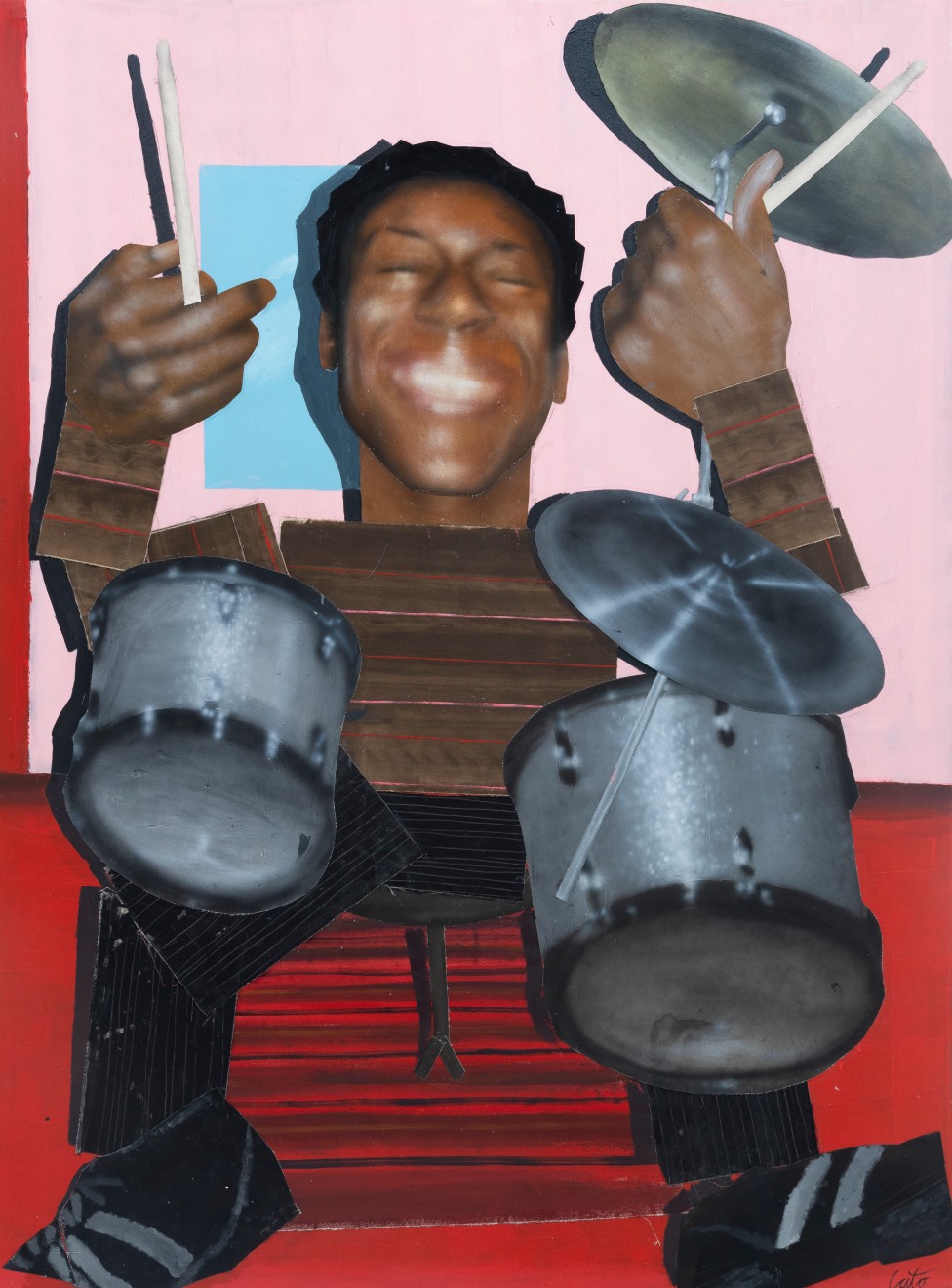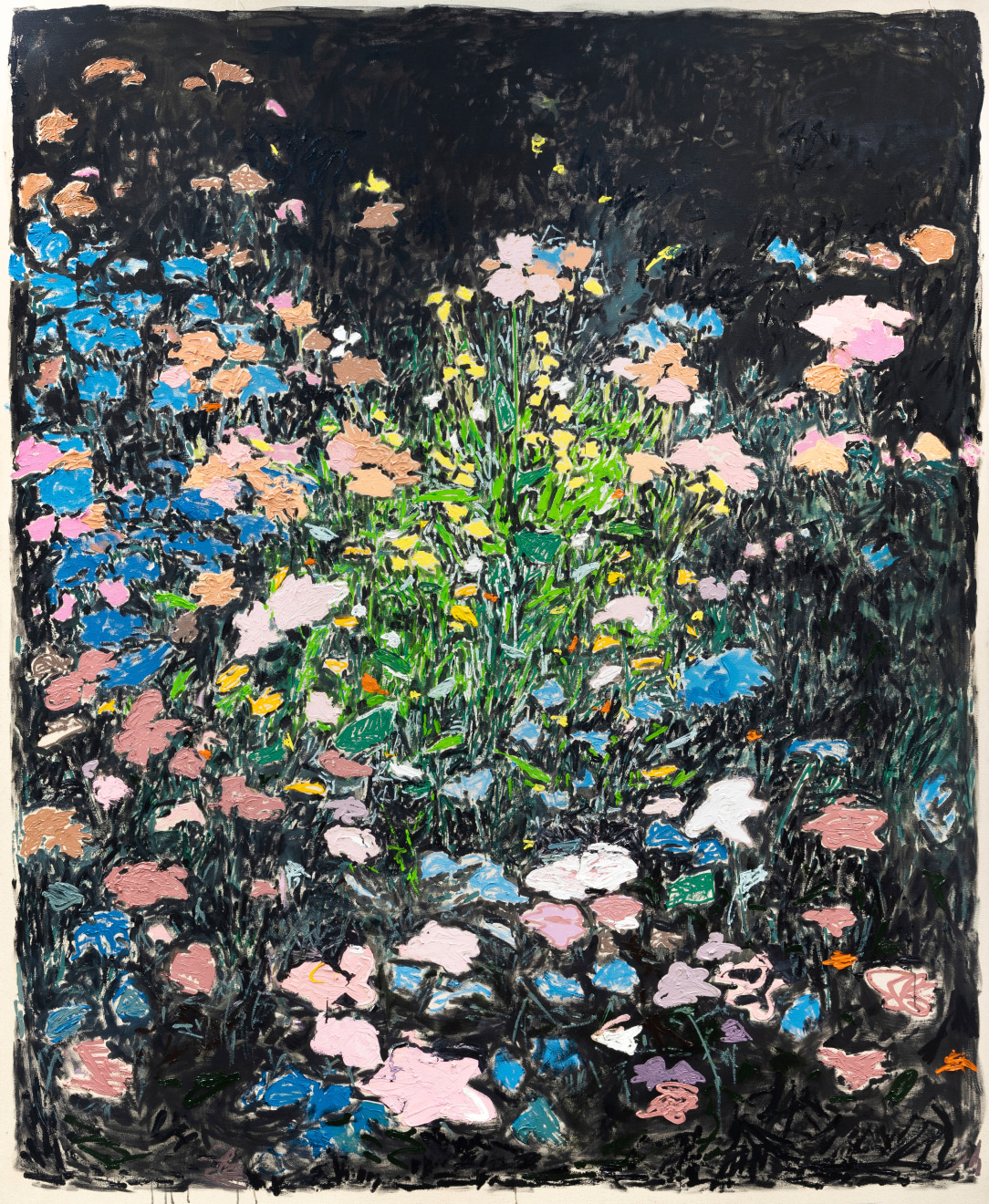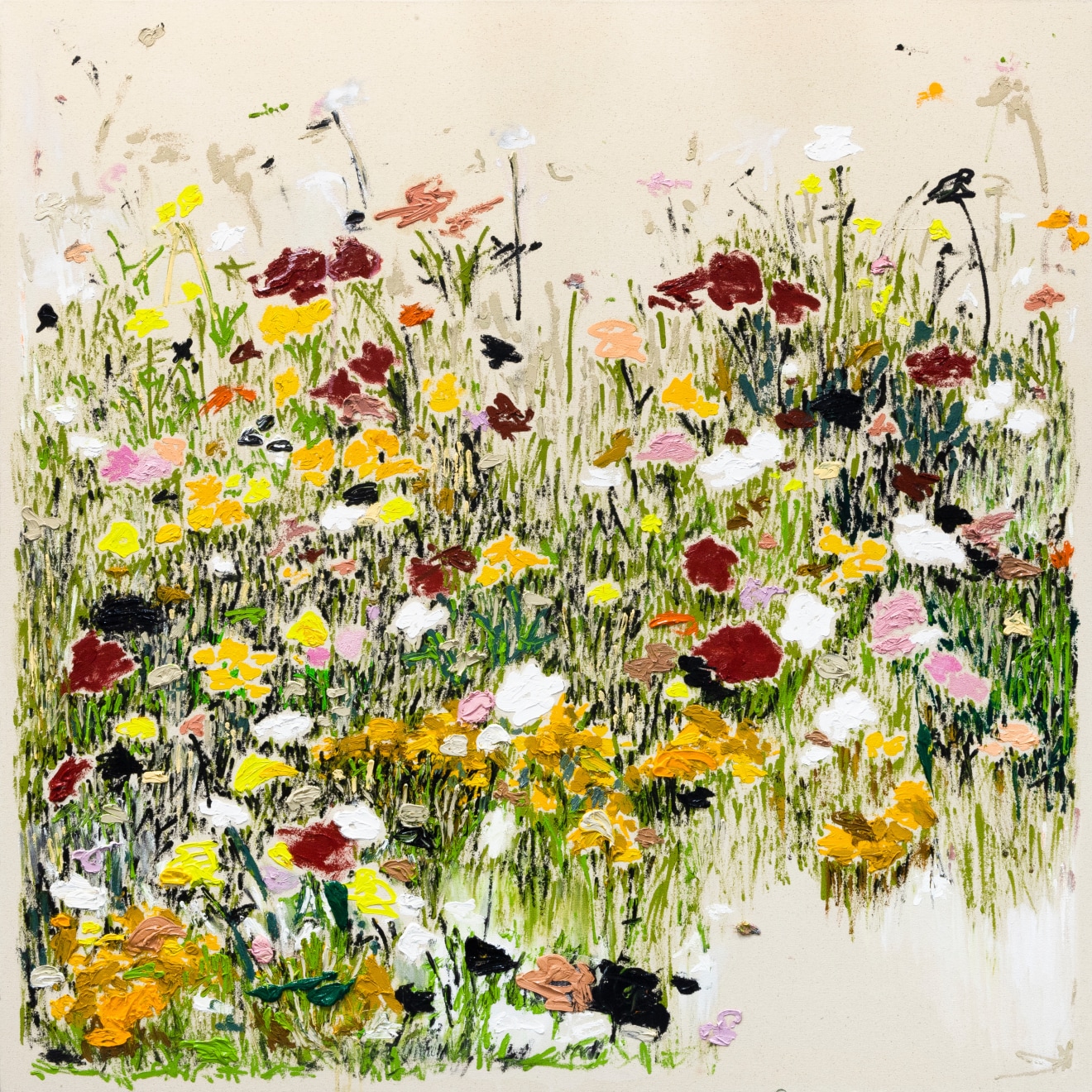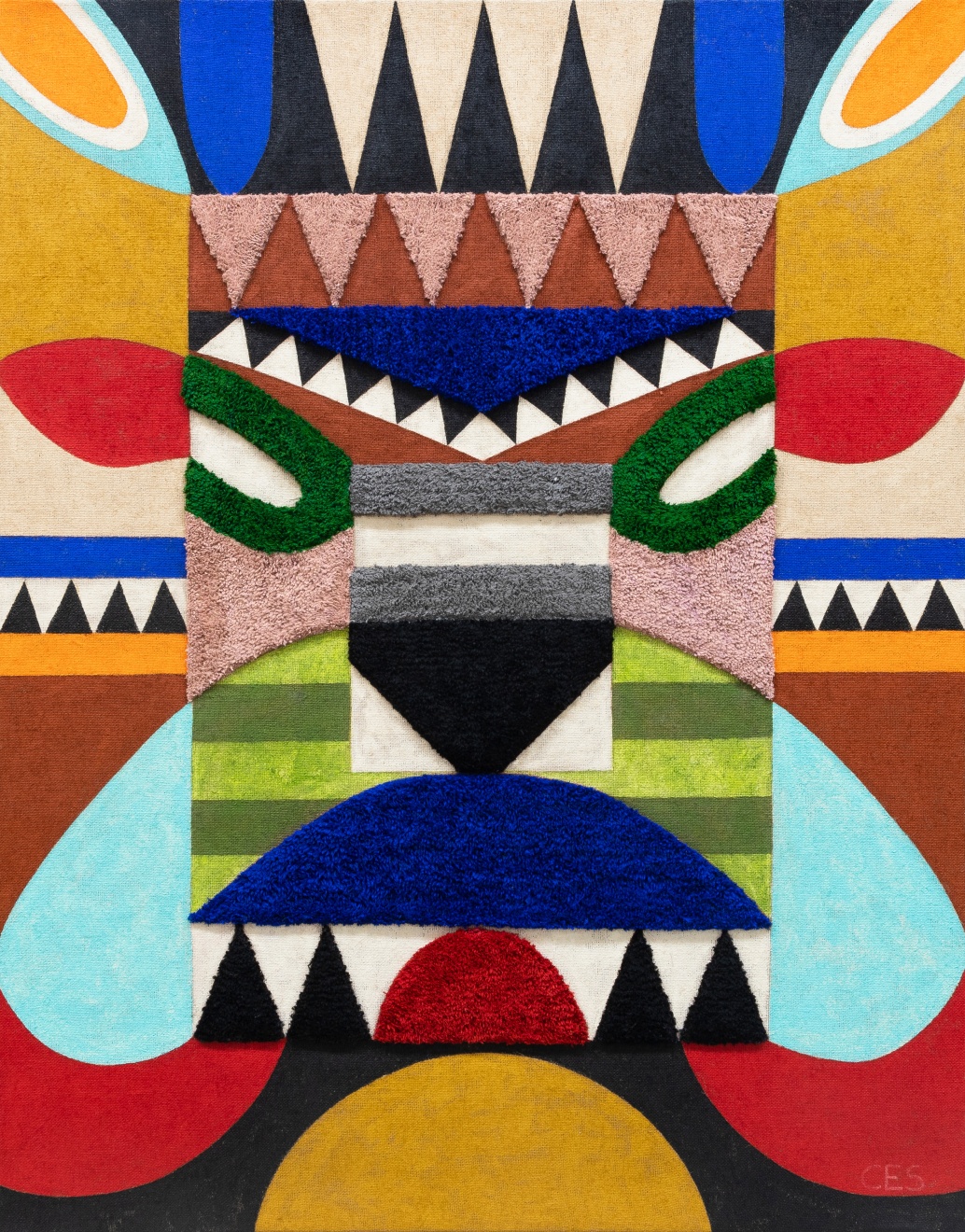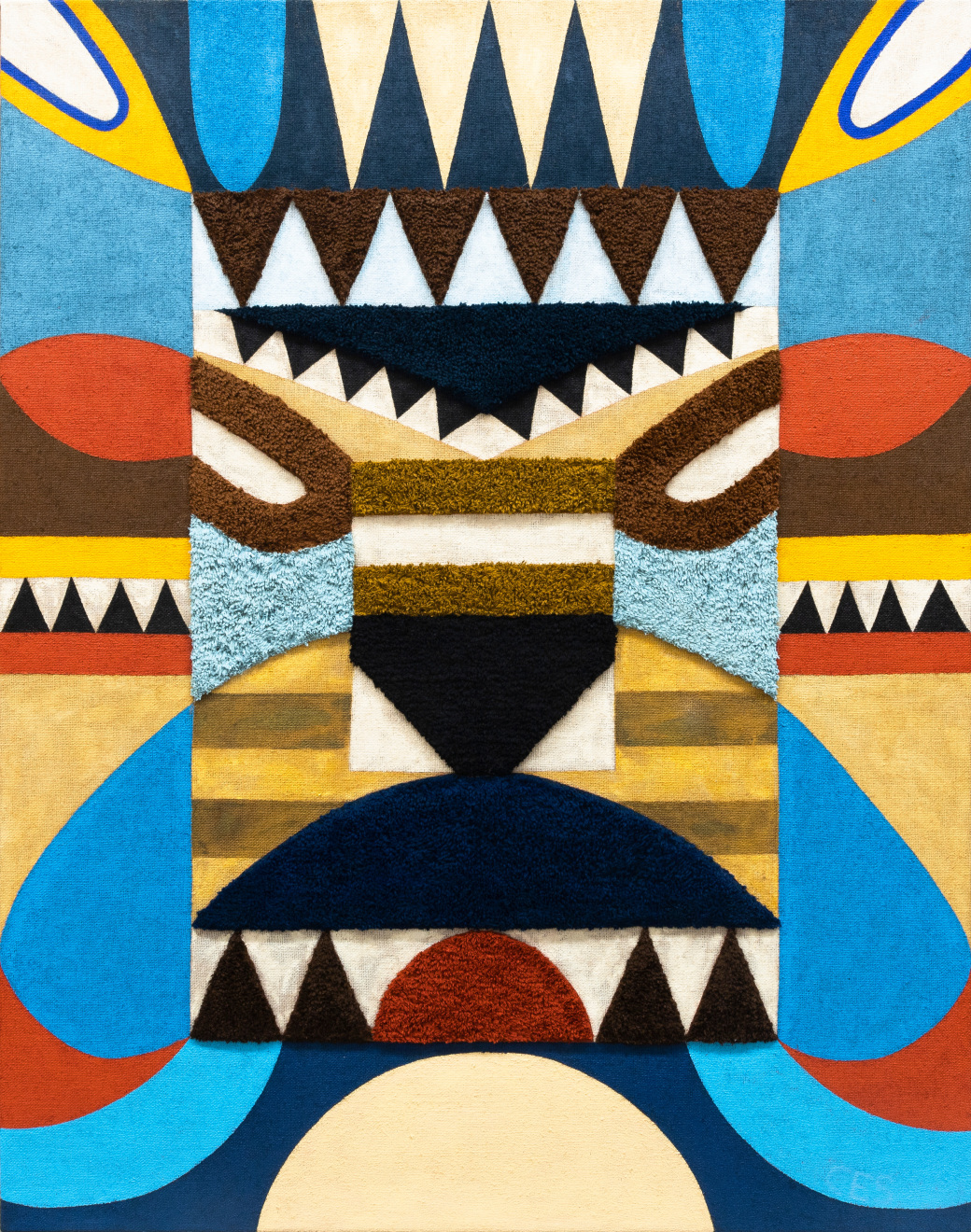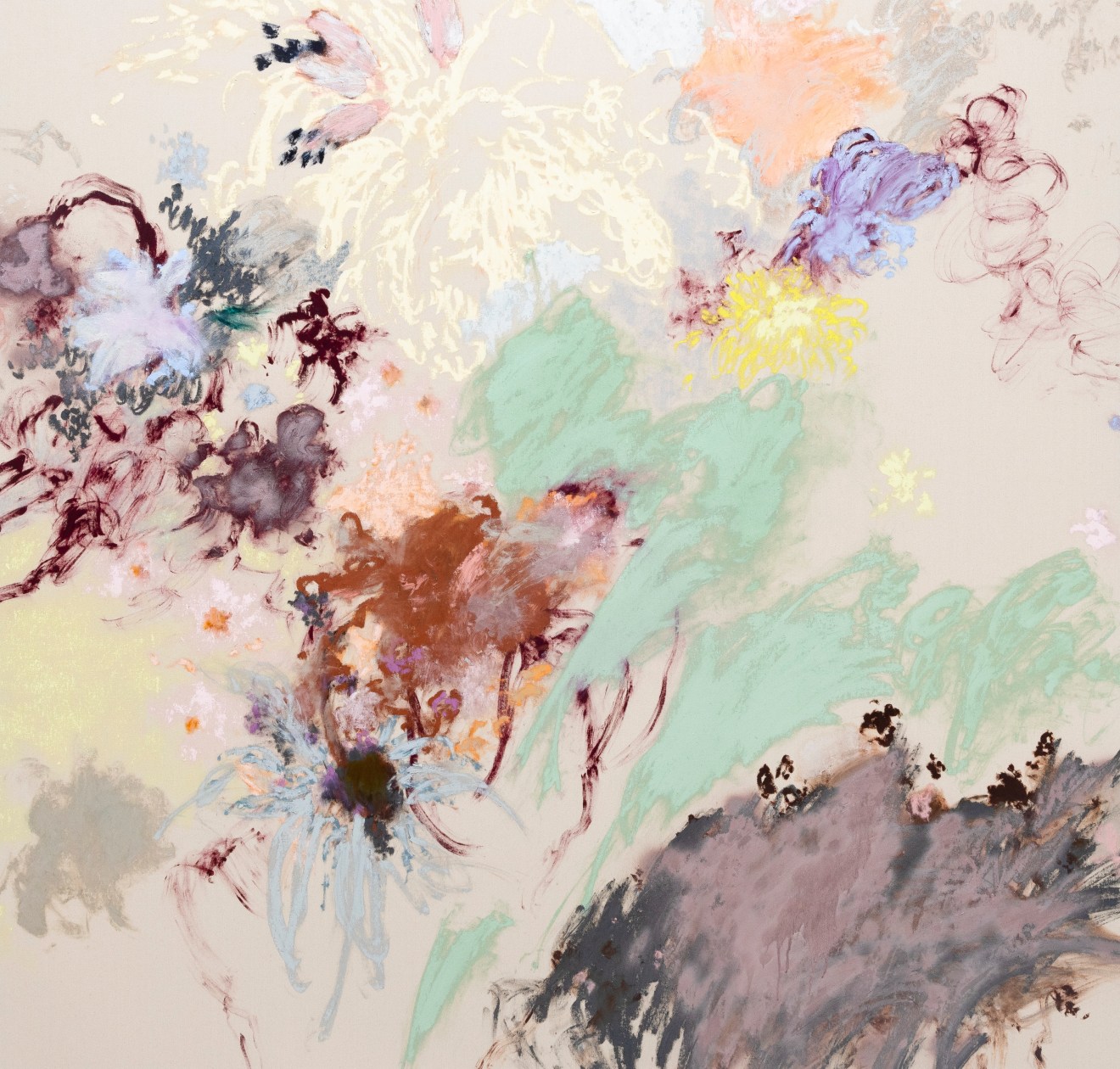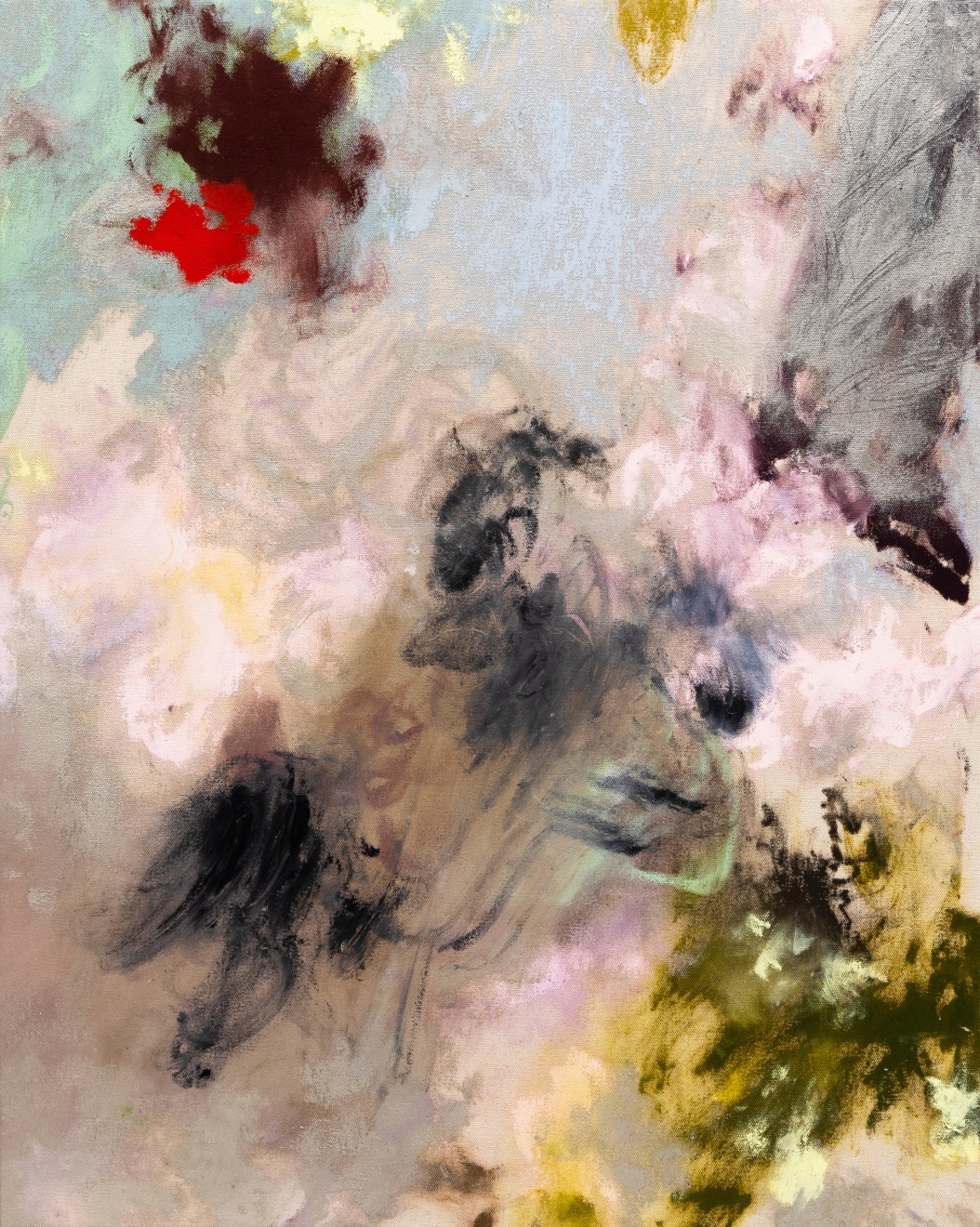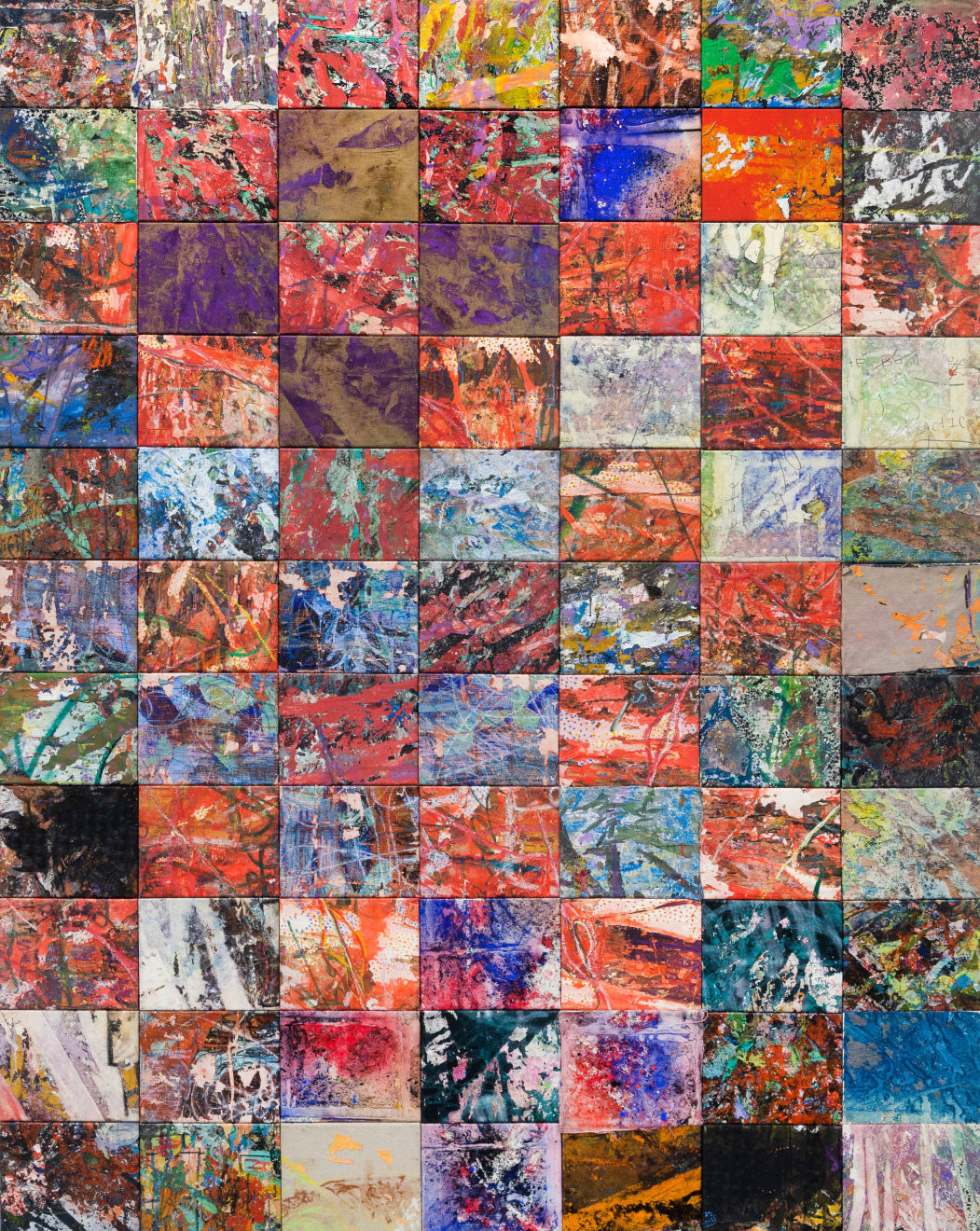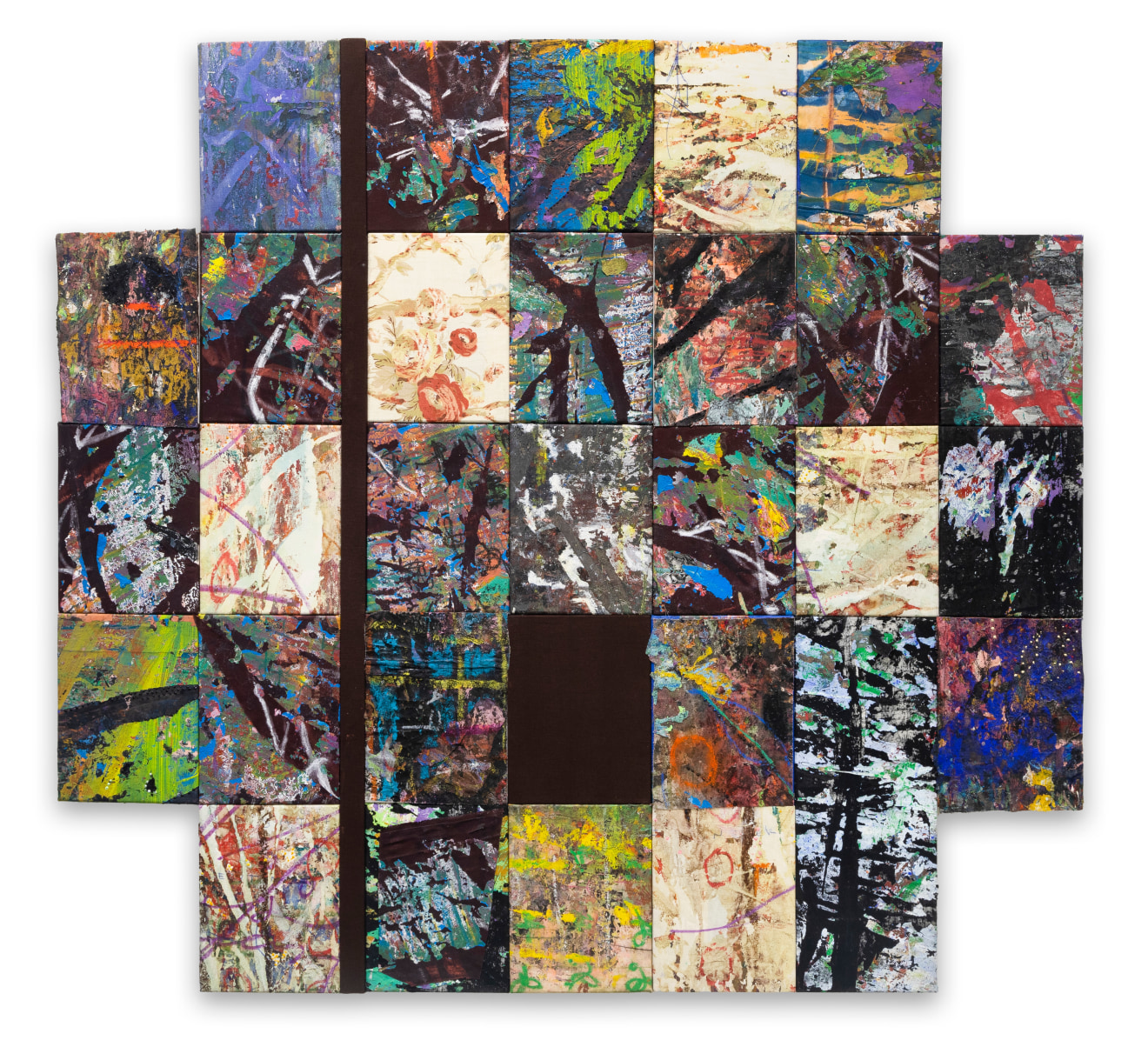Basie Allen · Javier Arce · Elise Asher · Ellsworth Ausby · Judy Bowman · Cato · Martha Edelheit · Susan Fortgang · Colleen Herman · Huê Thi Hoffmaster · Walter C Jackson · Christabel MacGreevy · Ces McCully · Acacia Marable · Joe Overstreet · Pat Passlof · Cybele Rowe · Paul Waters
Eric Firestone Gallery is pleased to announce its participation in the 2024 edition of The Armory Show. A cross-generational group of artists and estates will be on view, highlighting aesthetic connections across decades. With this installation, the gallery is pleased to introduce two artists: Walter C Jackson (b. 1940), a sculptor who was recently exhibited in the Just Above Midtown exhibition at the Museum of Modern Art; and Cybele Rowe (b. 1963), an Australian ceramicist based in Yucca Valley, CA, who makes monumental sculptures.
The work of Walter Jackson, Basie Allen, and Paul Waters combines inspiration from urban and rural spaces, as well as folklore and African art. Walter C Jackson’s sculpture juxtaposes natural materials—such as wood, sisal and jute fibers—alongside industrial plastic and aluminum. Jackson describes his practice as a “unity of opposites,” with symbolic reference to both African cosmology and Christian iconography influenced by his Methodist upbringing—within the structure of urban geometries. His totemic sculptures often frame openings, creating portals: their shapes inspired by West African Dogon sculpture, Moorish doorways, pyramidal constructions, and ecclesiastical architecture of the American South. Basie Allen (b. 1989) imagines a feral space between the uncertainty of nature and the inevitability of cities. His work combines multiple small canvas panels into a “mosaic” grid, signifying the rigidity of our urban spaces. Each panel is characterized by gestural brushwork, which were painted onto camping tarps before transferring the images onto muslin and linen. Tarps offer safety and protection—though often temporary and site-dependent—in both cities and nature.
Paul Waters (b. 1936), whose work will be included in the upcoming Edges of Ailey exhibition at the Whitney Museum of American Art, developed a unique technique of cut canvas collage beginning in the 1960s. Painted silhouettes suggesting primordial forms and imaginary animals are arranged and collaged onto canvas supports in rhythmic patterns. Waters exclusively uses his hands and fingers to apply paint, rather than brushes. The paintings reflect his interest in African art, indigenous traditions, children’s books, and a playful, intuitive form of communication.
Geometry runs through the work of Ellsworth Ausby, Ces McCully, and Acacia Marable. Ces McCully (b. 1982), an Australian artist now based in Southern France, uses interconnected geometric shapes to create her mask-like paintings. They seamlessly incorporate acrylic wool weaving within their surfaces. The resulting works are both hard and soft, masculine and feminine: meditations on divisions within society. Acacia Marable (b. 1988) paints on dart boards, adding oil paint and wire to the sisal surfaces which have their own inherent geometry. The broad areas of color become a way to investigate racial experiences, and the dart board a symbol used to explore ideas of play, perfection, and violence. Ellsworth Ausby (1942–2011) was dedicated to reflecting a deeply rooted African aesthetic and cultural heritage, responding to the geometry of ancient Egyptian art. In the 1970s, Ausby made unstretched canvases that were attached directly to the wall, utilizing high-keyed color and suggesting sonic rhythms.
An expressionist approach, sensations of the natural world, and lyrical brushwork can be found in the work of several artists on view, including Javier Arce, Elise Asher, Susan Fortgang, Colleen Herman, Hue Thi Hoffmaster, and Pat Passlof. The oil paintings of Javier Arce (b. 1973) oil paintings depict vivid natural scenes of trees and blooming wildflowers, inspired by the eco-fiction of Richard Powers and the philosophy of Michael Marder. His canvases are stretched on irregular repurposed untreated wood sourced from the artist’s countryside environment in Cantabria, Spain. Huê Thi Hoffmaster (b. 1982) creates calligraphic thickets of paint across his unprimed canvases. He depicts flower forms, although they are also stand-ins for figuration. His work oscillates between abstraction and representation, Eastern and Western painting traditions. Elise Asher (1912–2004) was a painter and poet whose integration of poetry into her works represents a significant contribution to New York School painting. Asher’s work of the early 1950s utilizes expressive, energetic linear brushwork and is composed in tight color families to create paintings that evoke or reference trees and plants. By 1961, Asher introduced text into these masses—blurring the line between brushwork and writing.
Susan Fortgang (b. 1944) is an abstract painter who approaches each canvas as an experiment, working out a specific problem or trying something new. She creates paintings with a physical presence, often using thick layers of paint to create textured surfaces or iridescent medium so that her works create different optical effects depending on lighting or as the viewer moves in space. Pat Passlof (1928–2011) was an abstract painter of the New York School who used repeated patterns and marks across the canvas to create dynamic rhythms, often suggesting abstracted landscapes. She drew upon experiences and memories, as noted by titles referring to people and places. She lived and worked in the Lower East Side of Manhattan, and also spent time in the Shawangunk Mountain area of upstate New York, where the space and air of the mountain ridge influenced her painting. Colleen Herman (b. Baltimore, MD, 1982) is an artist whose richly colored, blooming abstractions reflect seasonal changes and natural growth. Pouring, scribbling, and dabbing paint with her fingers, Herman embraces a process that is highly intuitive and playful. Herman has spent time in Oaxaca and Mexico City, and now lives and works between New York City and the Hudson Valley. The artist takes inspiration from the landscapes of all four places, alternatively tranquil, vibrant, and frenetic.
A series of 1980s paintings by Joe Overstreet along with the recent work of Cato and Judy Bowman explore storytelling, the city, and Black culture. Cato (b. 1999) is a multimedia artist who works with painted and collaged canvas forms to express Black culture and relationships between people. He mines a multitude of visual sources to create his paintings: historical archives, books, art history, and his own polaroids and street photography. Facial expressions drive the content and inspire his themes. There is a deliberate disjuncture between the photorealist style of the heads and hands—painted with airbrush, and the loose geometric styles and patterns of the settings, for which he uses brushes and paint rollers. Judy Bowman (b. 1952) is a collage artist whose practice centers on exalting Black American culture. Bowman’s use of vibrant hues, textured paper, and acrylic paint illuminates narratives that are reflective of her coming-of-age in Detroit’s Eastside and Black Bottom neighborhoods. Similar to Cato’s process, Bowman begins with the eyes of her figures, allowing the story to play out freely as she works.
Joe Overstreet's Storyville series investigates the music, rituals, and culture of the notorious district in New Orleans. Joe Overstreet (1933–2019) will be the subject of his first major dedicated museum exhibition in thirty years, opening January 2025 at The Menil Collection, Houston, TX. The paintings at Armory draw upon local folklore and legends, centering the lives of jazz musicians, sex workers, and New Orleans’s cultural hybridity. Bodies emerge through Overstreet’s filter of soft paint, establishing the fleeting nature of the oral history which informed his compositions. Using a palette knife, Overstreet includes fragments of decorative details which reveal the colonial history of the city, while washes of color evoke its thick humidity.
Feminist concerns, and depictions of the body through a woman’s lens characterize the work of Martha Edelheit, Christabel MacGreevy, and Cybele Rowe. Cybele Rowe (b. 1963) is a multidisciplinary artist whose monumental bronze casts, clay sculpture and ceramic works are defined by an exuberant abstract language of flowing patterns, colors, and organic shapes. Rowe draws inspiration from nature, Aboriginal art, and the body. Much of Rowe’s work focuses on her experience of the female body, particularly related to pregnancy and motherhood. In creating monumental ceramic works, Rowe considers the female body as a vessel, as it has been seen throughout much of art history, and as a productive lifeforce. Rowe visualizes harmonious and contradicting states of fragility, strength, and desire. The surfaces have pockmarks, scratches, and etchings, evoking the shifting capacities of the body. Christabel MacGreevy (b. 1991) is also a multimedia artist who began working with ceramic during a residency at Ceramica Suro in Guadalajara, Mexico. Her work subversively explores the performance of gender identity, personal and pagan mythology. Virginia Woolf’s Orlando was a defining influence with its gender fluid protagonist; and a recent series was inspired by the postmodern feminist novel Sexing The Cherry by Jeanette Winterson. MacGreevy envisions the figures on her vessels living out their lives with an expression of freedom, fluidity, and nonconformity. The work of Martha Edelheit (b. 1931) from the past sixty years is transgressive, whimsical, and sensuous all at once. It reflects her abiding love of art history and her reimagining of the discipline that was largely created by men, for men. In a series of 1970s pastels, Edelheit abstracts and defamiliarizes the woman’s body, with extreme close-ups of the torso: stomachs, breasts, and thighs. Her palette of reds, oranges, and pinks is warm and luminous; these pastels hum with erotic energy.

